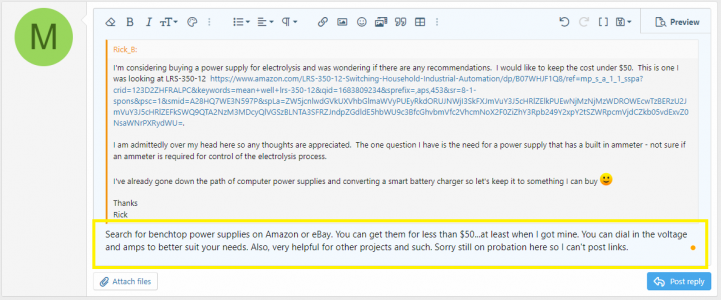Amp meters are cheap, aftermarket automotive ones can be found for a couple bucks.
More amps is good, trashcanworks, the simple home made, transformer and bridge is good.
Ours is all of those things!
30 gallon trash can on something like a pallet with a stand on one side to hold a couple large buss bars.
External shunt type ammeter in series with the buss bars.
Home made supply from large transformer and bridge rectifier.
Had some 12 volt batteries, places 3 in series and added connector for golf car charger.
Has a timer switch so it can run high voltage then switch to low.
Use lye as it attacks anything organic, so decreases, de-paints and de-rusts.
The water will get warm over time as the current flow does heat the water.
The higher voltage helps get things started when very little conductive metal is exposed.
The current will start slow, then rise as rust or other things blocking conductivity are worked from the material.
The electrodes will collect a bunch of stuff and look like crap, lift VERY CAREFULLY to get them out for cleaning.
This I'll be indicated by the current dropping back to small amounts.
For tall things, just flip them over.
Or, get a cheap tarp from HF, build a simple frame or dig a trench in the ground, think above ground swimming pool.
Place the tarp down, then your post, then fill with water.
Lay a chunk of rebar next to it and get it done.
Sent from my SM-G781V using Tapatalk
More amps is good, trashcanworks, the simple home made, transformer and bridge is good.
Ours is all of those things!
30 gallon trash can on something like a pallet with a stand on one side to hold a couple large buss bars.
External shunt type ammeter in series with the buss bars.
Home made supply from large transformer and bridge rectifier.
Had some 12 volt batteries, places 3 in series and added connector for golf car charger.
Has a timer switch so it can run high voltage then switch to low.
Use lye as it attacks anything organic, so decreases, de-paints and de-rusts.
The water will get warm over time as the current flow does heat the water.
The higher voltage helps get things started when very little conductive metal is exposed.
The current will start slow, then rise as rust or other things blocking conductivity are worked from the material.
The electrodes will collect a bunch of stuff and look like crap, lift VERY CAREFULLY to get them out for cleaning.
This I'll be indicated by the current dropping back to small amounts.
For tall things, just flip them over.
Or, get a cheap tarp from HF, build a simple frame or dig a trench in the ground, think above ground swimming pool.
Place the tarp down, then your post, then fill with water.
Lay a chunk of rebar next to it and get it done.
Sent from my SM-G781V using Tapatalk



